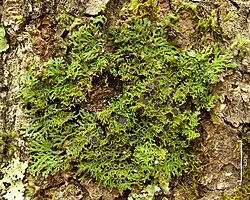Biology:Kurokawia palmulata
| Kurokawia palmulata | |
|---|---|

| |
| Scientific classification | |
| Domain: | Eukaryota |
| Kingdom: | Fungi |
| Division: | Ascomycota |
| Class: | Lecanoromycetes |
| Order: | Caliciales |
| Family: | Physciaceae |
| Genus: | Kurokawia |
| Species: | K. palmulata
|
| Binomial name | |
| Kurokawia palmulata (Michx.) S.Y.Kondr., Lőkös & Hur (2021)
| |
| Synonyms[1] | |
|
List
| |
Kurokawia palmulata is a species of corticolous (bark-dwelling), foliose lichen in the family Physciaceae.[2]
Taxonomy
It was formally described as a new species in 1803 by French botanist André Michaux, who named it Psoroma palmulatum.[3] In its taxonomic history, it has been proposed for placement in the genera Lecanora, Parmelia, and Physcia.[1] In 1899, Edvard August Vainio transferred it to the genus Anaptychia,[4] and it was known as a member of this genus until 2021, when Sergey Kondratyuk and colleagues transferred it to the newly circumscribed genus Kurokawia .[5]
Description
Anaptychia palmulata is recognisable by its foliose thallus, which is typically appressed and can grow up to 9–10 cm (3 1⁄2–4 in) in diameter. The colour varies from brownish-grey to tan-brown. Its lobes are elongated and linear, branching irregularly, and they remain mostly flat at the ends. Unlike some other lichens, Anaptychia palmulata does not possess soredia or isidia. However, it often develops lateral secondary lobules. The lichen's lower surface starts off white or off-white and gradually darkens to a tawny or light brown shade. A noticeable feature is the superimposed layer of hyphae, which does not carry rhizines. Commonly, Anaptychia palmulata will present with apothecia, which are laminal and can grow up to 4 mm in diameter.[6]
The chemical spot test reactions of the lichen often reveal a K+ (yellow) reaction on the upper surface, making it distinctive. The presence of variolaric acid has also been observed. However, the strength and prominence of these reactions can vary between specimens.[6]
Similar species
The distinct chemical reactions of Anaptychia palmulata to spot tests, especially when it comes to the excipular spot tests, coupled with its colour and morphology, make it stand out from other lichen species. However, care must be taken not to confuse it with similar-looking species like Physconia subpallida – which lacks the positive spot tests that are characteristic of Anaptychia palmulata. Another differentiation point is the cortex structure of these lichens, with Anaptychia palmulata having a prosoplectenchymatous upper cortex.[6]
Habitat and distribution
Endemic to eastern North America and eastern Asia, Anaptychia palmulata has been found to have a strong affinity for the bark of hardwood trees. However, it can also establish itself on rock surfaces, either directly or overlying mosses. The species is particularly prevalent in areas corresponding to the eastern deciduous forest. Additionally, a correlation has been noted between the geographical distribution of the lichen and the squarroseness of its rhizines – specimens from the southern range tend to have less squarrose rhizines compared to those from the north.[6] Its North America range was extended considerably when it was recorded from Ohio–the first report from western North America.[7] Its range extends north to southern Ontario,[8] and the coniferous old-growth forests of southwestern Nova Scotia in Canada.[9]
References
- ↑ 1.0 1.1 "Synonymy. Current Name: Kurokawia palmulata (Michx.) S.Y. Kondr., Lőkös & Hur, in Kondratyuk, Lőkös, Kärnefelt, Thell, Jeong, Oh, Kondratiuk, Farkas & Hur, Acta bot. hung. 63(3-4): 384 (2021)". Species Fungorum. https://www.speciesfungorum.org/Names/SynSpecies.asp?RecordID=841055.
- ↑ "Kurokawia palmulata (Michx.) S.Y. Kondr., Lőkös & Hur". Species 2000: Naturalis, Leiden, the Netherlands. https://www.catalogueoflife.org/data/taxon/B33JM.
- ↑ Michaux, A. (1803). Flora Boreali-Americana. 2. p. 321.
- ↑ Vainio, E.A. (1899). "Lichenes in Caucaso et in peninsula Taurica annis 1884–1885 ab H. Lojka et M.A. Dechy collecti" (in la). Természetrajzi Füzetek 22: 269–343 [299].
- ↑ Kondratyuk, S.Y.; Lőkös, L.; Kärnefelt, I.; Thell, A.; Jeong, M.-H.; Oh, S.-O.; Kondratiuk, A.S.; Farkas, E. et al. (2021). "Contributions to molecular phylogeny of lichen-forming fungi 2. Review of current monophyletic branches of the family Physciaceae". Acta Botanica Hungarica 63 (3–4): 351–390. doi:10.1556/034.63.2021.3-4.8. http://real.mtak.hu/143270/1/article-p351.pdf.
- ↑ 6.0 6.1 6.2 6.3 Esslinger, Theodore L. (2007). "A synopsis of the North American species of Anaptychia (Physciaceae)". The Bryologist 110 (4): 788–797. doi:10.1639/0007-2745(2007)110[788:asotna2.0.co;2].
- ↑ Newberry, Clayton C.; Clair, Larry L. St. (1991). "Additions to the Lichen Flora of Utah. I". The Bryologist 94 (2): 154–156. doi:10.2307/3243690.
- ↑ Wong, Pak Yau; Brodo, Irwin M. (1990). "Significant records from the lichen flora of southern Ontario, Canada". The Bryologist 93 (3): 357–367. doi:10.2307/3243528.
- ↑ McMullin, Richard T.; Duinker, Peter N.; Cameron, Robert P.; Richardson, David H.S.; Brodo, Irwin M. (2008). "Lichens of coniferous old-growth forests of southwestern Nova Scotia, Canada: Diversity and present status". The Bryologist 111 (4): 620–637. doi:10.1639/0007-2745-111.4.620.
Wikidata ☰ entry
 |

